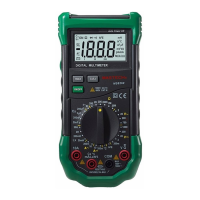service staff and you can get access to information
regarding related calibration, performance tests, and
services.
5.1 Routine maintenance
In order to avoid electric shock or damaging the
meter, please do not wet the interior of the
meter. Always disconnect the test tips from the
input signal before remove the shell or the
battery cover.
Use a damp mop and a small amount of detergent to
clean the shell of the meter periodically. Please do not use
abrasive or chemical solvents.
If the input sockets are fouled or wet, the measurement might
be affected.
Therefore, the input sockets need to be cleaned:
Turn off the meter, and pull out all test tips from the input
sockets.
Clean all dirt off the sockets.
Wet a new cotton stick with cleaner or lubricant (e.g.
WD-40).
Clean every socket with the cotton stick, and the lubricant
can prevent the sockets from contamination caused by high
humidity.
5.2 Replacing the Battery
In order to avoid electric shock or physical
hurting due to wrong readings, please replace the
battery immediately when “
”
symbol appears
on the display of the meter.
In order to avoid electric shock or physical
hurting, please turn off the meter and make sure
that the test tips are disconnected from the
circuit to be tested before taking off the battery
cover for replacing the battery.
19
Fig. 2. Replacing the Battery
Please follow the steps below to replace the battery (also see
Fig.2):
1. Turn off the power of the meter.
2. Pull out both test tips from the input sockets.
3. Use a screw driver to loosen the two screws fixing the
battery cover.
4. Take off the battery cover.
5. Take off the used battery.

